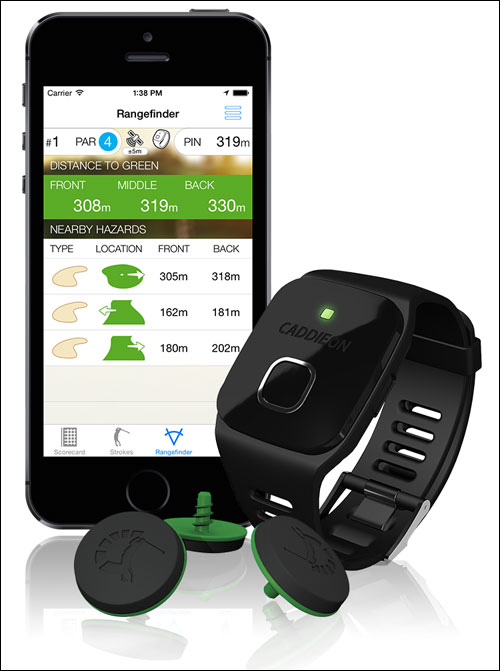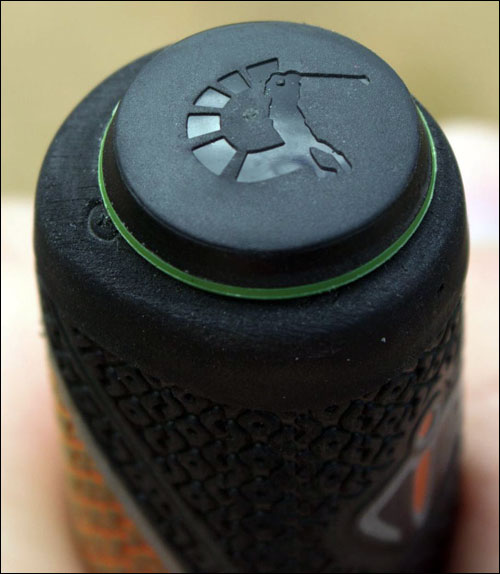Golfers can access a variety of technologies to help them assess how they’re doing—measuring the distance of their shots, determining their location on a course and tallying up their score. However, each of these technologies can require a golfer to perform some manual operation, such as aiming a laser or inputting the number of strokes. Finnish technology startup CaddieON has now released a solution requiring minimal manual involvement to enable golfers to gauge their performance while on the course, and after they go home. According to Osmo Voutilainen, CaddieON’s CTO, the solution—which combines radio frequency identification, Bluetooth and GPS technologies with CaddieON’s own app—was developed to be more automated and hands-free: A wrist-worn device reads a passive high-frequency (HF) RFID tag attached to each golf club’s hand grip, detects the individual’s swing and hit of a ball, and transmits that data to the CaddieON app running on the user’s smartphone, via a Bluetooth connection. The app then collects GPS data from the phone and sends the data package back to CaddieON’s cloud-based server two times—before and after each round of golf.

Tuomo Lalli, a company co-founder, is a golfer himself, and was initially looking into existing technologies to measure the quality of his game. Golfers often use a laser pointer to measure the distance of a completed shot by aiming it at the ball, but those measurements require some manual effort. In addition, Lalli says, some other golf-tracking systems on the market employ high-frequency (HF) RFID tags, but require players to tap an RFID reader against a club’s tag at every swing. CaddieON’s system is intended to make this process easier and more automatic, and to collect and manage data for the golfer on a personal portal that he can access whether on or off the course.
The wristband itself contains an ST Microelectronics Micro ST CR95HF 13.56 MHz RFID reader IC, compliant with the ISO 15693 standard, as well as an accelerometer to detect when a club is swinging and CaddieON’s own patented algorithms designed to determine when the club hits the ball as part of the golfer’s swing. Some other companies’ swing-tracking systems, Voutilainen explains, use an impact sensor to determine whether, and when, the club has hit the ball. “We found that was not very reliable,” he states, “so we developed our own sophisticated algorithms.” The GPS data collected by the phone enables a golfer to identify where a ball was hit, and that location information can then be compared against that of the previous hit, thereby identifying the previous shot’s length.
The solution, which includes 15 tags for clubs, costs €299 ($378). The tag itself needed to be small, so CaddieON selected a Lab ID inlay measuring 14 millimeters (0.6 inch) in diameter. CaddieON embeds the inlay in a plastic casing with a threaded projection that can be screwed into the top of a golf club’s grip.
The Caddie-On app is available for Android smartphones and iOS devices. A golfer downloads the app and creates a user account by inputting relevant data, such as his name. Once the account has been opened, that individual can select a favorite golf course, as well as register his clubs. To accomplish the latter, the player attaches an RFID tag to the top of each club’s grip, enters that club’s description—such as 9-iron—into the app, and taps the wristband against the club’s tag in order to link the tag ID to that description.
When playing a round of golf, a user can open the app and view where on the course he is located on a Google Maps display, based on GPS data from the phone. He can then decide which club to use, based on that location data.
When he begins to play, the golfer taps his wristband against the club tag. The reader antenna is located in the device’s wrist strap. The device’s sensors detect the swing and hit of the club against a ball, that data is sent to the phone via a Bluetooth connection, and the phone forwards that information to the server. Until the golfer taps a new tag on a different club, each swing will be associated with that club. He then walks to the ball, and the GPS data determines the previous shot’s distance. The golfer can view that data on the app via his phone, or wait and review it later from his computer or tablet at home. While on the course, the player can also use the app to view such information as distances to the green and hazards.
A rechargeable battery provides the CaddieOn device with approximately 10 hours of play time—the equivalent of two full rounds of golf. It can then be recharged using the provided USB adapter.
The app shows a player’s improvement over time, based on the shots’ accuracy and distance, and the quantity of strokes. The RFID data provides information indicating which clubs are proving to be most successful for that player.
Golfers have been purchasing the Android version of the system since its commercial release this past spring, Voutilainen says, and a small group are serving as testers, providing feedback about how well the system works and how it might be improved. The company is now in the process of inputting more golf courses into its app (most courses throughout Finland and Sweden are currently included, and the firm is adding courses according to customers’ specific needs and locations).



